EDC Symposium: Part Four
by Andy Corrigan
Showcase
Each and every contribution over the two days could deservedly stand alone in a “showcase”, but my intention for this session went beyond just providing space for the uniqueness and value of some of the projects and initiatives to shine. Despite initially seemingly to be somewhat disparate, my hope was that the more nuanced connections and complexities between these initiatives might in fact be drawn out, highlighted and discussed.
The first of our showcase initiatives was StoryFutures, Helen O’Neill and Destiny Lawrence (Royal Holloway, University of London). StoryFutures and the StoryFutures Academy are research, development and training programmes that initially ran from 2018-2023, and have ambitious plans to continue. They have trained over 900 librarians and run over 120 workshops, integrating immersive tech for innovative storytelling across the country. The key take-away from working on this scale, is that it has shown how the more stories you tell, the more connected they become. This bold and ambitious approach also demonstrates that the pedagogical aspects of public libraries and collections are just as central in our relationship with the digital landscape as those in more research focussed contexts.

– The more stories you tell, the more connected they become. StoryFutures.
The Uncertain Space is a virtual museum for the University of Bristol, that is being developed by Stephen Gray (Head of Research Support, University of Bristol), who is also another representative from this cohort of AHRC-RLUK Profesional Practive Fellows. The latest virtual space is Wildfilm Located, which acts as a spatial catalogue interface to over 100 hours of interviews with significant people from the world of natural history film making. The intention of this initiative is to go beyond simply “gamification”, and has been developed with input from a group of autistic adults to help explore the effectiveness of this technology to provide more intuitive and effective access to digital archives. Stephen’s work establishes that there is fundamentally more to digital catalogue interfaces than just the underlaying data and content, and that innovative ways to interact with those things are universally just as essential. Having set-up a demonstration in the next room, Stephen was able to offer us first-hand experience of his work whilst we collectively discussed it, which created a marvellously enriching sense of a collective embodied experience.
Next, we heard from Simon Popple and Cassie Ulph (University of Leeds) about the development of the Digital Creativity and Cultures Hub at the University of Leeds Libraries. One of the most exciting initiatives they have been working on, is a programme of paid internships for undergraduate students. Each internship includes up to 140 hours of paid work over a year, some budget for attending professional opportunities and equipment and mentorship from one of the hub’s specialists. The five project themes included “Welcoming Migrants”, which is opening up University collections to migrant communities, “Born in Bradford Digital Makers”, which is supporting coding skills for school children, as well as a project exploring the application of IIIF to 3D collections, collections as data, and creative interpretations of special collections. Through the way they have positioned and shaped the DCCH, Simon and Cassie’s work at Leeds epitomises the role that libraries can play as a central hub in a digital ecology/landscape, in that it not only creates content, but enables people to discover new pathways into, around, and through that landscape.
Our final showcase in the session explored the “Re-entangling the Visual Archive” project that we heard Sally Kent and Jenni Skinner discuss during the ‘Processes of Collaboration’ panel session. Project lead Kerstin Hacker (Anglia Ruskin University) shared some of the insights and outputs that herself and Sana Ginwalla (Zambia Belonging), worked on with two Zambian artists, Edith Chiliboy and Maingaila Muvundika. In addition to their individual critical creative practices, they also facilitated collaborative knowledge creation through communal making. This refreshing and hopeful project is a powerful demonstration of the huge impact that can be achieved by inviting creative practitioners into library and archive spaces, and especially in tackling some of our more challenging issues. For me, it also reflects the complex nature of the digital landscape, and the appropriateness of challenging what it means to us as a fluid aspect, and how that impacts the balance of the embodied and virtual.

– Photos taken during the showcase session.
This post has been funded by the AHRC-RLUK Professional Practice Fellowship Scheme for research and academic libraries.
